#sydney roper
Explore tagged Tumblr posts
Text

Sydney Roper, Taylor Bagley and Terra Jo Wallace by Jennifer Steinglen
127 notes
·
View notes
Text



Terra Jo Wallace, Taylor Bagley, Sydney Roper - Playboy
83 notes
·
View notes
Text
The Night Manager interview
As the title character on Fox’s long-running medical drama “House,” Hugh Laurie managed to find empathy in the grumpy, sarcastic diagnostician. Now he’s taking on an even more challenging task: starring as the so-called “worst man in the world” in AMC’s miniseries “The Night Manager” (premiering April 19).
In this modern-day adaptation of the John le Carre spy novel, Richard Roper presents himself to the world as a successful businessman — but behind the scenes, he’s exchanging in illegal arms deals.
Here, Laurie tells Variety how he went from playing the hero to the villain in a project that was twenty years in the making.
Why did you decide to sign on for the role?
I was, first of all, immensely flattered to be approached by the actual, the Cornwell family themselves, Cornwell being John le Carre’s real name. I had loved this book since I first read it when it was published in 1993. As a teenager, having devoured all of le Carre’s wonderful Cold war novels, I was a little nervous, as I’m sure a lot of people were, that the end of the Cold War would mean not only would spies be out of work, but spy writers would be out of work. I didn’t know what le Carre was going to write about, if he could find another subject worthy of his talents. I was about three chapters into “The Night Manager,” and I actually put the book down and tried to option the book. I’m still not entirely sure what that means. I’m not a natural born producer. I’ve heard the phrase bandied about.
And what happened?
Sydney Pollack already had it. He sat on it for, I’m not sure how long. Possibly until he passed away. Then, for one reason or another, it reverted to the Cornwell family and they decided to revive it and I was just so excited that this thing that I dreamed of, that I’ve been in love with for so long, nearly 23 years, was finally coming to life. Of course, back when I first read it, I imagined myself in the role of Jonathan Pine, the hero, the night manager. Time moves on, hair falls out, knees get creaky, and I had to move up to the veterans, older 50s division, and move into the role of the villain. It was still an honor to be involved. I would have done anything. I would have played any role or done anything to be involved in it.
The producers decide to put a modern twist on it, and set it in the modern day. How did you feel about that?
I was nervous, honestly to begin with. I think that as a general rule, the attempt to modernize something, to keep up with the times, you’re often chasing your own tail, really because modern times, by definition, are unpredictable. For example, no one saw the Arab Spring coming when it happened. For all the NSA spy satellites circling the globe, no one saw that one coming. No news organization saw that coming. I thought it would be just as likely that we would change the story to accommodate the new set of global events and in between us making it and the show coming out, maybe the Colombian drug cartels would hit the headlines again, which is where the story was originally set.
Under the sure hand of the director, Susanne Bier, I think it’s turned out really well. It seems to be just getting more and more topical with every week that goes by. There have been stories in the press recently about ISIS getting ahold of chemical weapons and no one knows where they got them from. Who’s been selling them these weapons. This is a trade and it’s a pretty unpleasant one. For better or worse, well probably worse, the British and the Americans are involved in it. There’s a great deal of money to be made. To some extent, we are actually dependent on it. In the end, it just feels it was a very smart decision. I don’t know who made it, but whoever made the decision really needs to take some credit for it.
I’d imagine taking on the role of Richard Roper, who’s described as “the worst man in the world” was a bit ominous. How did you find your way into it?
In my own deluded imagination, I felt like I knew this character the instant he appeared on the page when I first read the book. I just thought, “God, I could believe this guy, I could see the way he moves.” Le Carre was so specific about the rhythms of his speech, and his body language, his manner. I just felt like I knew him incredibly well, which is useful because when it comes to actually researching the role of the worst man in the world, it’s rather difficult. You can’t call someone up and say, “I’m playing the worst man in the world and I’d like to base him on you. Can we have lunch?” That doesn’t go terribly well.
I think Tom Hiddleston had a much easier job because he’s only got to say, “I’m playing the hero.” Everyone, of course, they fall all over themselves to unlock the vault and let him have the run of the place. The worst man in the world, it’s a little more difficult. Fortunately, I just I felt like I’ve known this guy for 20-odd years. He’s stayed in my mind and my memory so vividly.
Is there any good in Roper at all?
I don’t know if it’s good, exactly. There are things that I like about him even though he’s probably irredeemable. One of them is, I think that he at least has the guts to know he’s terrible. He knows that he’s going to hell. In fact, I even wonder whether he’s hoping to go to hell. He knows he’s a damned soul and he wants to be caught. I think it’s one of the interesting dynamics of the whole thing is that I have this feeling that Roper wants to be betrayed. There’s a strange sort of Christ allegory here. You know when you read about these crazy serial killers, these psychopaths, the police eventually come knocking on the door and the guy says, “What took you so long?” They’re almost relieved to be caught. They know that something in them has gone wrong. They know they’re going to hell and they want it to be over. I think there is an element of that in Roper. As psychopathic as he is, I don’t think he’s not someone who would whine about being treated unfairly. I think he knows what he’s done and he knows what he deserves. That I thought in a strange sort of way, I slightly admire. I try not to, but I do slightly.
What did Susanne Bier, the director, bring to the project?
Everything. I mean, absolutely everything. If there’s any credit to be had for this entire adventure, it’s all hers because she was just remarkable. What’s she’s managed to achieve here, making effectively, three feature films back to back, or six movies, in half a dozen countries with 200 actors and a crew of God knows how many, thinking and working, operating in a second, sometimes a third and fourth language, controlling all these elements, doing it with such grace and good humor, intelligence, and taste and skill is just remarkable. I can’t say enough about her. She’s been absolutely remarkable.
She was a surprising choice, I think. I mean, she obviously is an immensely well regarded film maker. She’s won an Oscar, and she’s done an enormous amount of really terrific films, but first of all, she’s not English. She is, I think as far as I know, has no sort of connection to this world, either the world of intelligence gathering or even the more general description of this particular tribe of Englishmen. Either Pine’s tribe or Roper’s tribe.
But as soon as I met her, I thought, this is going to be absolutely great. I know we’re going to disagree, and we did. We disagreed a lot, but in the best kind of way. It’s great to be made to justify why you think something and be forced to think things through. If you agree with everyone around you, I think it tends to not make for good results. It’s certainly true in music, isn’t it? You always hear the bands that fought a lot actually made much better records than the ones that were just a band of brothers. Their records always sound a bit dull because of it. I think the disagreement is healthy and good. I really enjoyed it. I hope she did, too. I hope she didn’t think I was a pain in the ass for disagreeing. It was really thrilling to engage with some of that intelligence and taste.
Talk about working with Tom Hiddleston. How was he as a scene partner?
I couldn’t imagine myself doing the role. That’s how instantly he inhabited it. I’d thought I’d be going into this thing going, “That could have been me 20 years ago. I’d have done it differently.” Actually, I saw him do this thing and instantly he became the character of Jonathan Pine, he filled it to the brim. He’s an incredibly committed and conscientious guy who will never walk away from something if he’s got anything left in the tank. He’s immensely intelligent. When he thinks things through, they really get thought. They stay thought. He throws himself into things physically and emotionally with such absolute commitment. He’s never trying to protect himself or hold anything back. A lot of actors do, I think. They feel they got to protect themselves. They go, they mustn’t risk anything here. I’ve got to make sure I don’t come out of this badly. I’ve got to look out for myself. Once he’s in, he’s in. He’s in all the way. It was a glorious experience. We got along really, really well. Probably too well for the sake of the story. Maybe we should have had a little bit more friction, but we couldn’t generate any.
And Elizabeth Debicki, who plays Jed, your love interest.
She was just magnificent. Absolutely magnificent. She’s very tall, as you know. That’s good for everybody’s posture on the set. We all got taller, I think working around Elizabeth. Some of the characters, Roper and Pine, particularly, I suppose one could argue that they treat Jed as a token to be moved around the chess board. It would be easy, I suppose, for her to just passably allow that to happen without actually creating something real and meaningful. \She was so fiercely intelligent and funny, and just determined not to be that chess piece.
3 notes
·
View notes
Text
Footpath Guides: Sydney Inter-War 1915-1940

Footpath Guides: Sydney Inter-War 1915-1940 by Footpath Guides Text and Photography by Jaques Sheard Design and Art Direction by Sonia Post Produced by Dave Roper Here I am again. Already late to posting my next review and the my backlog of completed books growing. It’s a good thing I have a decent memory and I take notes. This one is somewhat of an unconventional book review. This book is a collection of brief descriptions on the historical context and architectural design of various buildings in Sydney that were erected between 1915 and 1940. It includes photos, fun design to the pages, and a map taking you on a route from building to building. I picked this book up from a Museum while on a trip in Sydney, and woke up early one morning to walk the laid out path and read each description as I came to each building. The small paragraphs on each building gave a good feel for the context the building was designed in, and some of the specific design choices made. A sense of the culture of the time in regards to architecture came through strong as you move from building to building. The selection of buildings themselves were beautiful and intriguing, and even the ones I didn’t quite like had a charm to their ugliness. It also included a selection of “Of Note” buildings off the outskirts of the main path that you could take a moment to appreciate along the way. Some of my personal favourites from the selection were the Grace Building, the BMA House, The Railway House, and the State Theatre which was one of the aforementioned “Of Note” buildings. I had a lot of fun doing the walk and reading along the way and this is definitely something I want to try to do again when I visit new cities. Happy reading folks. Don’t think too hard about the book you’re on right now, just enjoy it.
0 notes
Photo

19 notes
·
View notes
Photo





Team Canada: Women’s Eight Rowing
Lisa Roman + Kasia Gruchalla-Wesierski + Christine Roper + Andrea Proske + Susanne Grainger + Madison Mailey + Sydney Payne + Avalon Wasteneys + Kirsten Kit, Gold
247 notes
·
View notes
Text
People, February 8 -- part 1 of 2
Cover: What Queen Elizabeth is really like
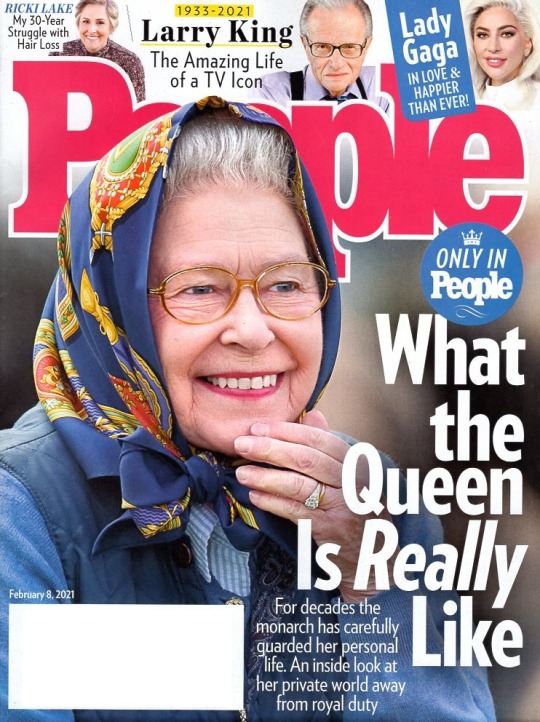
Page 3: Chatter -- Tim McGraw on his initial reaction to Taylor Swift's 2006 breakout single Tim McGraw, Chris Evans on constantly losing ChapStick, Gabrielle Union on husband Dwyane Wade not being a fan of her sex scenes in L.A.'s Finest, Drew Barrymore on her definition of happiness, Dwayne Johnson on detangling the hair of his daughter Tiana, Billie Eilish on feeling kind of stupid for not knowing the cost of everyday items
Page 4: 5 Things We're Talking About This Week -- celebs get in on the Bernie Sanders meme, Kate Hudson offers up a love fern for Valentine's Day, Bridgerton will be back, Drivers License sparks love-triangle drama, Michelle Pfeiffer heads to the White House
Page 6: Contents

Page 7: Editor's Letter
Page 8: StarTracks -- President Biden takes office -- President Joseph R. Biden Jr. and Dr. Jill Biden waved to the public outside the White House which is their new residence after he was sworn in as the 46th President of the United States
Page 9: Kamala Harris is sworn in as the first woman and woman of color to be Vice President, before her swearing in she fist-bumped President Barack Obama, Jennifer Lopez wore a white Chanel ensemble to perform This Land Is Your Land and America the Beautiful
Page 10: Katy Perry closed the day's celebrations with a performance of her song Firework in front of a large firework show over the Washington Monument, tapped by Dr. Jill Biden poet Amanda Gorman became an overnight sensation after reading her powerful poem The Hill We Climb during the Inauguration, Former Presidents and First Ladies -- Barack and Michelle Obama, George W. and Laura Bush, Bill and Hillary Clinton
Page 11: Heidi Klum took a break from filming the next season of Germany's Next Top Model to attend the virtual About You Fashion Week in Berlin, Chris Pratt enjoyed a round of golf before getting to work filming his next movie Thor: Love and Thunder in Sydney, Cardi B wore a see-through dress by designer Pierre-Louis Auvray for a shopping trip with husband Offset in Beverly Hills
Page 12: Stars on Set -- Cate Blanchett wore a face shield while filming Don't Look Up in Boston, Hilary Duff bundled up and covered her growing baby bump with an envelope clutch on the NYC set of Younger, Lily James held a camera while shooting the romantic comedy What's Love Got To Do With It in London
Page 13: Forest Whitaker got into character in NYC while filming Godfather of Harlem, Leonardo DiCaprio and Jennifer Lawrence shared a laugh while on the Don't Look Up set in Boston, Babies On Board -- Country singer Brett Young and his wife Taylor who are already parents to daughter Presley are expecting their second child, MSNBC anchor Katy Tur is expecting her second child a baby girl due in May with her husband CBS This Morning coanchor Tony Dokoupil and the new addition will join their son Teddy
Page 17: Scoop -- Lady Gaga in love on the world stage
Page 18: Teen star Jojo Siwa comes out
Page 20: Heart Monitor -- Kourtney Kardashian and Travis Barker new couple, Bachelor Romance Updates -- Clare Crawley and Dale Moss split, Nick Viall and Natalie Joy dating, Tanner Tolbert and Jade Roper Tolbert happy anniversary
Page 21: Pierce Brosnan's passion for painting
Page 22: A Legendary Showdown -- Patrick Mahomes and Tom Brady are set to battle in Super Bowl LV --a look at how these star quarterbacks match up on and off the field -- Patrick Mahomes of the Kansas City Chiefs vs. Tom Brady of the Tampa Bay Buccaneers (go Bucs!)
Page 23: Rehab Addict's Nicole Curtis -- why I came back, Daisy Ridley on life after Star Wars
Page 24: Passages, Why I Care -- Justin Hartley advocates to support veterans through PTSD-therapy services and trained animals
Page 25: Hank Aaron -- a baseball legend who changed the world -- one of the sport's greatest players Aaron defied death threats and became a civil rights champion -- Famous Fans Pay Tribute -- George W. Bush, Levar Burton, Ken Burns, Lenny Kravitz
(continued)
#tabloid#grain of salt#tabloid toc#tabloidtoc#queen elizabeth#hank aaron#justin hartley#daisy ridley#nicole curtis#rehab addict#tom brady#tampa bay buccaneers#patrick mahomes#kansas city chiefs#super bowl lv#pierce brosnan#kourtney kardashian#travis barker#jojo siwa#lady gaga#inauguration#president biden#president joe biden#dr. jill biden#kamala harris#barack obama#michelle obama#bill clinton#hillary clinton#heidi klum
3 notes
·
View notes
Note
If you get this, answer with three random things about yourself and send this to the last seven blogs in your notifications– Anonymously or not! Let’s get to know the person behind the blog! ✨
Oooh this is cool!
1. I love to do impressions, but very obscure ones e.g. one time American Idol auditionee Mary 'Guilbeax' Roach and Shirley Phelps Roper of the Westboro Baptist Church. @alcxhardy can attest to these 😉
2. I nearly got thrown off a cha cha ride at Sydney Luna Park as a kid, my cousin had to grip my arm the whole time to prevent me from flying away. Another time (it may have even been the same day), I slipped down the Joy Wheel in the Coney Island section and lost some skin off my back. Such fun! 🎪
3. From the ages of 12-14, I had a steady obsession with Bollywood films/music videos and most importantly anything starring Aishwarya Rai. Look up Dola Re Dola or Kajra Re on Youtube and see why💃🏽✨
3 notes
·
View notes
Photo






Chloé Kramer, Kitty Louvit, Nour Rizko & Sydney Rae Roper for Urban Decay 'BROW FINISH' 2019 Campaign.
Photographer: Carin Backoff Stylist: William Graper HairStylist: Esther Langham MUA: Marla Belt
29 notes
·
View notes
Link
Meanwhile, in Los Angeles, Jennifer Stenglein captures a trio of uninhibited blondes.
2 notes
·
View notes
Photo







‘Off-Duty’ Izzy Wild, Lou Schoof & Wayne Booth for KING KONG Magazine — Spring/Summer 2018.
Photographer: Barnaby Roper
Stylist: Michelle Cameron
HairStylist: Bok-Hee
Mua: Marla Belt
Casting director: Sydney Bowen
www.kingkongmagazine.com
13 notes
·
View notes
Text
15 Excellent Indigenous Art Centres To Support And Celebrate!
15 Excellent Indigenous Art Centres To Support And Celebrate!
Indigenous Art
by Sally Tabart
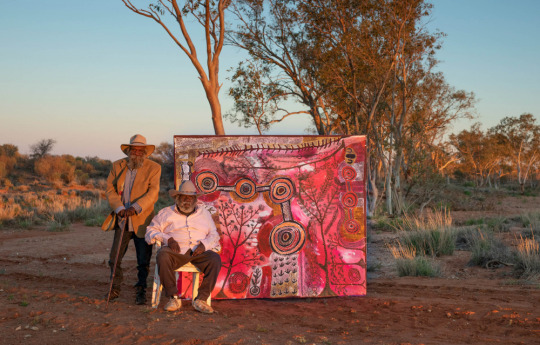
Peter Mungkuri and Alec Baker with their collaborative painting ‘Nganampa Ngura (Our Country)’ (2020) Photo – Meg Hansen, Courtesy of Iwantja Arts.
It’s important to know that Aboriginal artists and art centres are not all one homogenous group – each have their own style, stories, methods, materials and traditions that are unique to their Country and culture, that often cannot be practiced elsewhere. Through the artwork produced in community art centres there is so much to be learned about the spirit, culture and history of our country’s First Nations people.
There are a few things to keep in mind when purchasing artwork by Indigenous artists. Supporting art centres that are Aboriginal owned, operated and governed means that economic autonomy remains within the community. I asked Shilo McNamee, Darwin Aboriginal Art Fair Foundation’s (DAAF Foundation) artistic director, why this is important.
‘Art Centres are the beating heart of Indigenous communities. Supporting art centres ensures that Australia’s Indigenous art sector continues to flourish and excel’, she says. ‘The economic independence of communities helps ensure that people can continue to live on their homelands, resulting in the preservation of traditional practices, ceremonies, language, art and spirituality.’
Another important thing to look out for is that the art centre (or anywhere you are purchasing Aboriginal artwork from!) is a signatory of the Indigenous Art Code (IartC). This is a code of conduct (the Code) that art dealers, art centres and galleries can join to demonstrate their commitment to fair and ethical dealings when working with Indigenous artists. When art centres become signatories of the IartC, they are considered Dealer Members. ‘These businesses are committed to the fair and ethical trade with Aboriginal and Torres Strait Islander artists, and transparency in the promotion or sale of artwork’, says Gabrielle Sullivan, CEO of the Indigenous Art Code. ‘Dealer Memberships signifies a commitment to act fairly, honestly, professionally and in good conscience in all direct or indirect dealings with artists.’ Members of the IartC will generally display a logo on their website. You can read more about the IartC’s recommendations for buying ethically here.
As far as what percentage of an artwork purchase goes directly back to the artists, DAAF’s Executive Director Claire Summers notes an industry standard as guideline. ‘Art centres have systems in place to ensure artists are paid ethically. It is an industry standard for artists to receive 60 per cent of the sale price, with 40 per cent returning to the Art Centres, to continue their important work in the community’, she says.
You should also expect to receive a Certificate of Authenticity (CoA) with artwork purchases over $250.
Now you’re equipped with the information to make an ethical purchase from an art centre – WHERE TO START? Many art centres have great websites and Instagram pages where you can learn more about the artists, their Country and their practice, and shop their artwork online. The Darwin Aboriginal Art Fair – who return 100% of all sales directly to the participating artists and art centres – has recently announced they will be going online this year from August 6th – 11th (check out their list of all 75 participating art centres and register for early access here), and the annual Tarnanthi Festival in South Australia has a great online portal for navigating their Art Fair’s participating art centres here.
To get you going, we’ve put together a list of 15 art centres that are Aboriginal owned and operated, signatories of the Indigenous Art Code, and showcase a diverse range of the incredible work being produced by artists of the world’s oldest living culture.
Please note this is by no means an exhaustive list – according to the IartC, there are over 60 Aboriginal and/or Torres Strait Islander-owned art centres who are members of the IartC! This is a place to start – we encourage you to keep looking, learning, supporting and celebrating!

Left: Betty Muffler with her painting ‘Ngangkari Ngura’ (2020). Right: Eric Barney with his painting ‘Ngura (Country)’ (2020). Photo – Meg Hansen, Courtesy of Iwantja Arts.

Tiger Yaltangki with his painting ‘Self Portrait’ (2020). Photo – Meg Hansen, Courtesy of Iwantja Arts.
Iwantja Arts
Iwantja Arts is located in the rocky, desert country of Indulkana Community on the Anangu Pitjantjatjara Yankunytjatjara (APY) Lands in the remote north-west of South Australia. Founded in the 1980s by respected Anangu artists and community leaders Alec Baker and Sadie Singer, Iwantja Arts now supports the artistic careers of over 40 predominantly Yankunytjatjara artist members, providing access to artistic and professional development.
Many renowned artists have been nurtured and supported at Iwantja Arts, including Sulman Prize-winning Kaylene Whiskey and Vincent Namatjira, who became the first Aboriginal artist to win the Archibald Prize in 2020.
Artist Vicki Cullinan says, ‘The Iwantja art centre is the most important place in our community. It’s a place where everyone comes together, young and old. It’s really special. Families are working together. A lot of times people are singing inma (cultural songs) while they work. Iwantja Arts is a place where people can work to make money for their families. Everyone needs a job and working as artists means that we are also keeping our culture strong and passing on important knowledge to the next generations.’
Visit the Iwantja Arts online store here and follow them on Instagram here.

Left: ‘Iwantja Tjukitji (Iwantja Soakage)’ by Julie Yatjitja of Iwantja Arts. Right: Leah Brady, at the APY Studio in Adelaide.

Left: Nyunmiti Burton in front of her painting at APY Gallery Adelaide. Right: ‘Kapi Tjukula’ by Yaritji Heffernan.
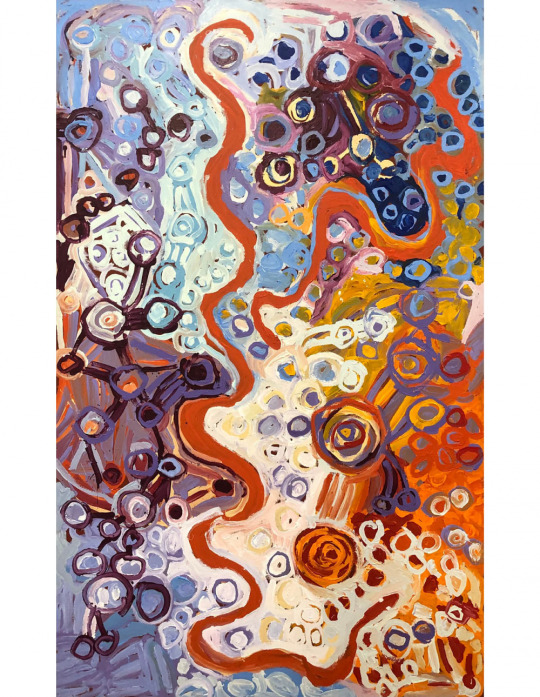
‘Wanampi Tjukurpa’ by Kukika Adamson.
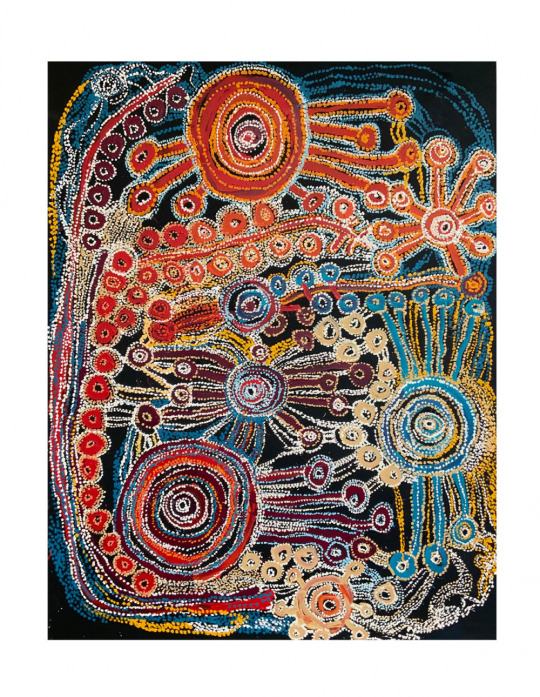
Artwork by Sharon Adamson of Tjala Arts.
APY Gallery
The Anangu Pitjantjatjara Yankunytjatjar (APY) Centre Collective is a group of 11 Indigenous owned and governed enterprises. The APY Galleries in Adelaide and Sydney are run by APY Art Centre Collective, creating a platform to exhibit and celebrate the work of young and emerging APY Artists.
The Anangu Pitjantjatjara Yankunytjatjara Lands (APY Lands) are located in remote Central Australia. The galleries represents the work of seven art centres – Mimili Maku Arts, Tjungu Palya, Ninuku Arts, Tjala Arts, Iwantja Arts, Kaltjiti Arts, and the Tjanpi Desert Weavers – facilitating sales and marketing the work of over 500 Indigenous artists. APY Art Centres are powerful places, and vital to the community.
The APY Galleries showcases artists working across a wide range of mediums from painting, traditional punu (wood) carving, weaving, textiles, new media and digital photography. These emerging young artists have watched, listened and learned from their grandparents, the senior men and women of the APY Lands.
Visit the APY Gallery online store here and follow them on Instagram here.

Epic woven hat by Doreen Djorlom of Marrawuddi Art Centre. Photo – courtesy of Marrawuddi Art Centre.
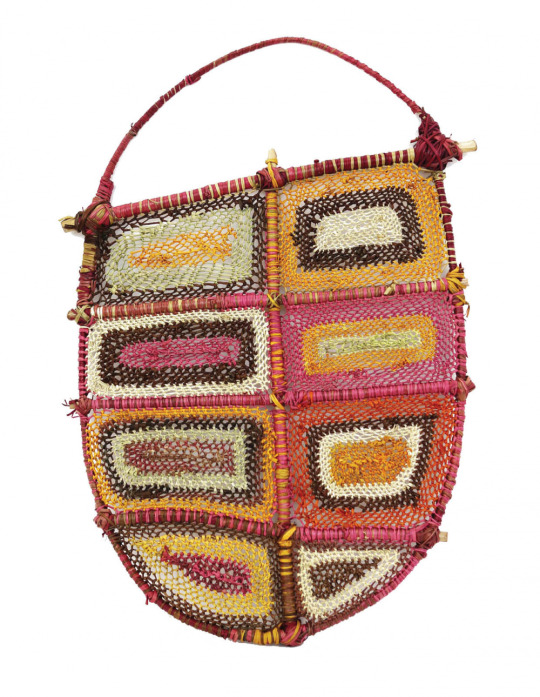
Weaving by Melba Gunjarrwanga of Marrawuddi Art Centre. Photo – Marrawuddi Art Centre.
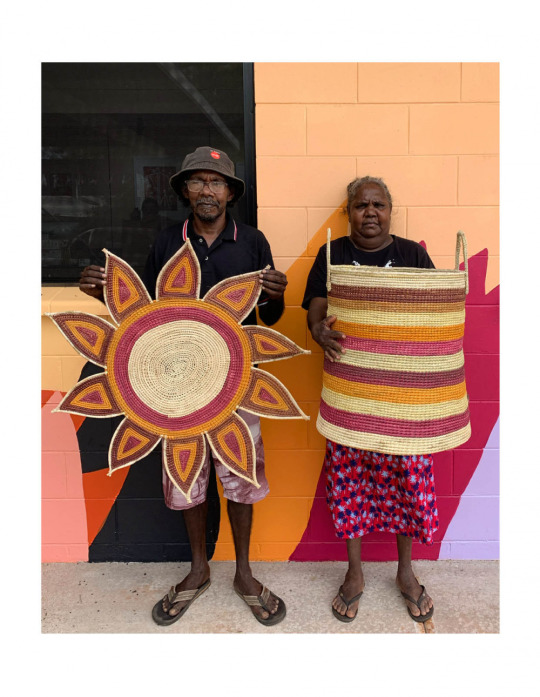
Amy Namarnyilk and her partner Rodney, with Amy’s incredible weavings! All hand woven with pandanus, which have been collected and dyed with natural dyes. Photo – courtesy of Marrawuddi Art Centre.

Patsy Kelly and her sensational Marebu! Photo – courtesy of Marrawuddi Art Centre.

Painting by Robert Namarnyilk of Marrawuddi Art Centre.
Marrawuddi Arts Centre
Marrawuddi Arts & Culture is located in the heart of the Kakadu National Park and works with over 400 artists from the Kakadu and West Arnhem region. Marrawuddi is a vibrant community hub providing working space for artists, stunning artworks for tourists to view and purchase and excellent coffee for everyone. Recently relocated to a stunningly renovated space right in the town of Jabiru, Marrawuddi is the first business to secure a lease under the post-mining plans for of Jabiru. The town was handed back to the Mirarr traditional owners in June 2021 as part of the long-awaited transition away from imposed uranium mining.
Artists at Marrawuddi practice painting methods that draw on traditions used for thousands of years. Using manyilk (sedge grass) and ochre, artists create patterns called rarrk, commonly known as cross hatching. Contemporary art methods such as screen printing and fine art painting are also practiced here, and the daluk (women) of Kakadu and West Arnhem also create incredible pandanus fibre art. Alycia Marrday of Marrawuddi Arts & Culture is a finalist in the Handcrafted category of the 2021 TDF Design Awards!
Marrawuddi is owned and controlled by the Mirarr clan through their representative organisation the Gundjeihmi Aboriginal Corporation (GAC).
Mirrar Traditional Owner Simon Mudjandi said at the opening of Marrawuddi’s bright new location in 2020, ‘Today is the start of a new and exciting chapter for Jabiru and Kakadu. With the opening of the new Marrawuddi Arts Centre, Jabiru’s transition from mining town to an Aboriginal owned community centre and tourism hub really begins.’
Visit the Marrawuddi online store here and follow them on Instagram here.

Artwork by Gwenneth Blitner of Ngukurr Arts. Image – courtesy of Ngurkurr Arts.
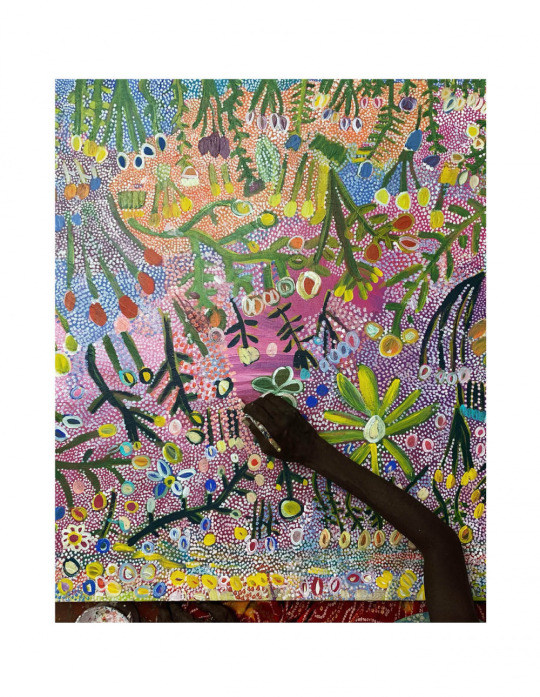
Gwenneth Blitner at work! Photo – courtesy of Ngukurr Arts.

‘Crayfish’ by Wally Wilfred Ḏakawa of Ngukurr Arts. Image – courtesy of Ngurkurr Arts.

‘Station Life’ by Jill Daniels of Ngukurr Arts. Image – courtesy of Ngurkurr Arts.
Ngukurr Arts
Ngukurr Art Centre is positioned by the banks of Roper River, at the south-eastern most cusp of Arnhem Land. The Art Centre, much like Ngukurr (which means ‘place of many stories’), is abundant with diverse histories, traditions and stories – bringing together many different clans and language groups. The community is home to Ngalakgan, Alawa, Mangarrayi, Ngandi, Marra, Warndarrang, Nunggubuyu, Ritharrngu-Wägilak and Rembarrnga, known collectively as Yugul Mangi (meaning ‘all of us together’). Here, the artists draw from personal history, cultural memory, Ancestral knowledge, ceremonial responsibilities and varied artistic influences, experimenting with colour, form and representation.
‘Melabat plenti langgus mob bat melabat bin migim wan pipurl. Dismob ting migim melabat strongbala,’ says senior culture man 78-year-old Walter Kolbong Rogers. Translating from Roper Kriol he says: ‘We are many language groups, but we came together and now we are one people. This art makes us strong.’
Visit the Ngukurr Arts online store here and follow them on Instagram here.
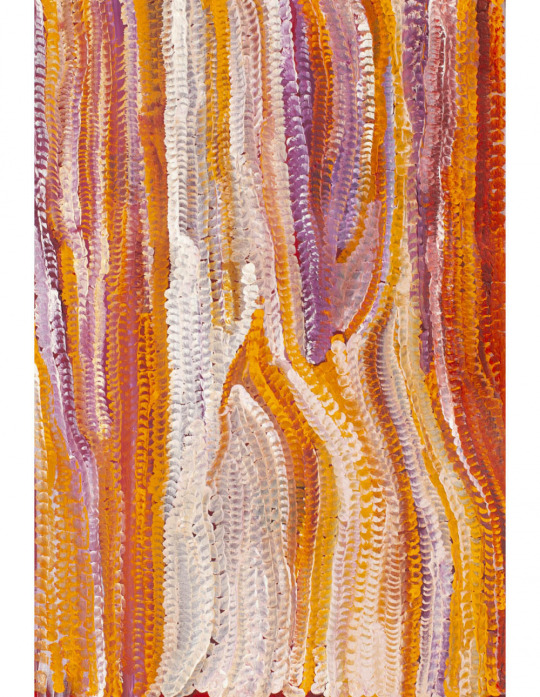
‘Wantili’ by Cyril Whyoulter of Martumili Artists. Image – courtesy of Martumili Artists.

‘Parnngurr Community’ by Bugai Whyoulter of Martumili Artists. Image – courtesy of Martumili Artists.
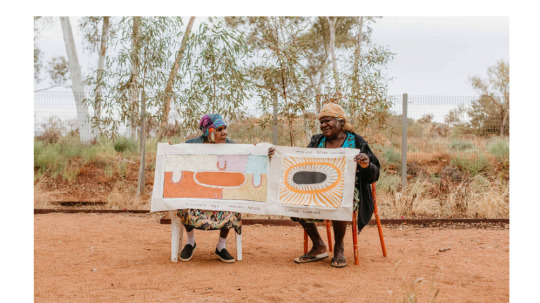
Martumili artists Elizabeth Toby and Lorna Linmurra. Photo – Kate Shanasy.

Left: Martumili artists painting at the art centre. Right: Artist Judith Anya Samson. Photo – Kate Shanasy.

From Left to right: ‘Untitled’ by Ivy Bidu, Untitled by Bugai Whyoulter, Nyurnma by Muuki Taylor of Martumili Artists. Images – courtesy of Martumili Artists.
Martumili Artists
Martumili Artists was established by Martu people living in the communities of Parnpajinya (Newman), Jigalong, Parnngurr, Punmu, Kunawarritji, Irrungadji and Warralong. The artists and their families are the traditional custodians of vast stretches of the Great Sandy, Little Sandy and Gibson Deserts as well as the Karlamilyi (Rudall River) area.
Bright, bold and expressive art making represents the exuberant personalities of the Martu people.
Younger Martu artists typically begin painting with their parents, grandparents and extended family, fostering an organic process of learning – not only about painting techniques, but also specific locations, family histories, traditional ways of life, bush tucker and Jukurrpa (Dreaming).
In this year’s Vivid festival in Sydney (postponed to September this year), eight Martumili artists will have their work light up the sails of the Sydney Opera House, bringing to life their 2013 collaborative artwork ‘Yarrkalpa (Hunting Ground), Parnngurr Area’!
Artist Corban Clause Williams of Martumili talks of the transfer of cultural knowledge from senior Martu artists to the younger generation: ‘The old people, they sit down and paint and tell stories of the old days, and we listen and learn.’
Visit the Martumili online store here and follow them on Instagram here.

Pirrnpirrnga – Desert Bore by Ann Lane Nee Dixon of Ikuntji Artists. Photo – courtesy of Ikuntji Artists.
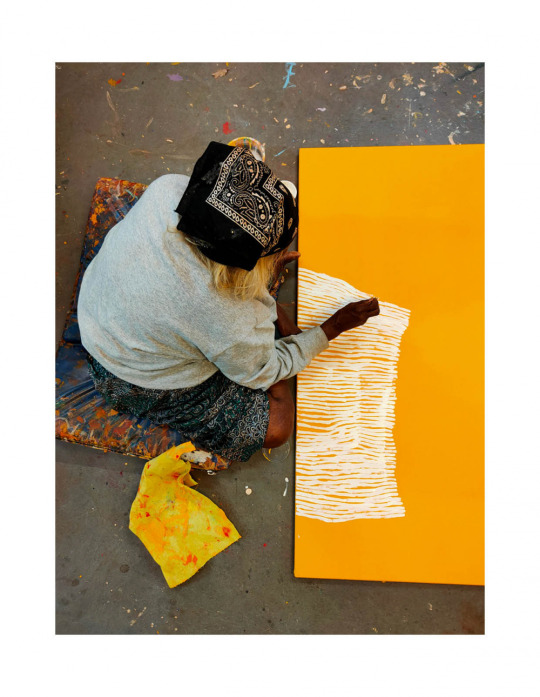
Artist Eunice Napanangka Jack working on a painting for a show. Photo – courtesy of Inkuntji Artists.
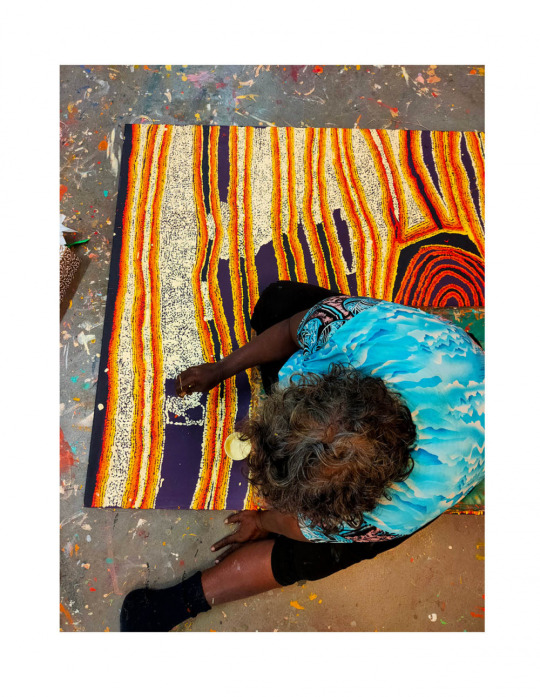
An Ikuntji artist working. Photo – courtesy of Inkuntji Artists.

Sheraldeen Marshall modelling pieces from the beautiful Inkuntji Artists x Publisher Textile collection! Photo – Christian Koch
Ikuntji Artists
Founded in 1992, Ikuntji Artists was the first art centre established by women in the Western Desert Art Movement.
Situated in the community of Haasts Bluff (Ikuntji) in Central Australia, which has a population of around 150 people, Inkuntji Artists has a board of seven Indigenous directors all of whom live and work locally.
Known also for their textile designs, recently Inkuntji have collaborated with Publisher Textiles on a clothing collection featuring the bold textile designs by artists Keturah Zimran, Mavis Nampitjinpa Marks, Eunice Napanangka Jack, Lisa Multa and Leonie Kamutu the collection shortlisted in the Textile Design category for the TDF Design Awards!
Artist and textile designer Keturah Zimran says, ‘I feel really proud of myself and my kids, seeing the paintings on the clothes. My dream is to keep doing the paintings, to keep going..… so I can teach my grandkids.’
Visit the Inkuntji Artists online store here and follow them on Instagram here.
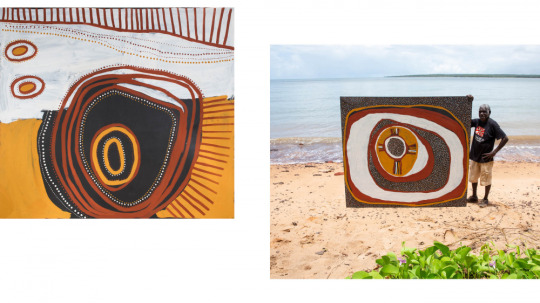
Left: Ngiya Murrakupupuni by Dino Wilson of Jilamara Arts. Right: Timothy Cook with his painting Kulama and his Country Mananowmi in the distance, 2021. Photo – Will Heatcote for Jilamara Arts
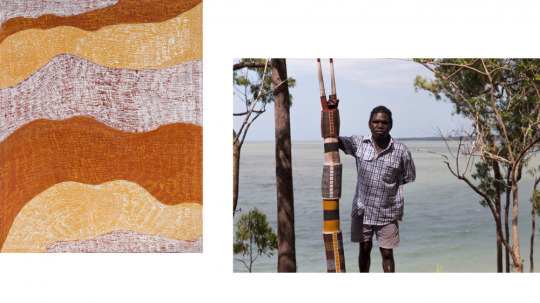
Left: Ngiya Murrakupupuni by Michelle Woody Minnapinni of Jilamara Arts. Right: Pedro Wonaeamirri with his Tutini for NIRIN BoS, 2020. Photo – Will Heathcote for Jilamara Arts
Jilamara Arts + Crafts Association
Located in the community of Milikapiti on the north coast of Melville Island (off the coast of the Northern Territory), Jilamara Arts + Crafts Assoication represents Tiwi art from up to 60 local artists. Established in 1989, they are highly respected for work based on jilamara (body paint design), Tiwi creation stories and unique island ceremonies such as Kulama and Pukumani.
The Tiwi Islands have been separated from mainland Australia for at least 3000 years, leading to the development of regionally distinct creative practices.
Jilamara Arts and Crafts is fully owned and governed by Tiwi artists from the Milikapiti community, led by an Executive Committee of nine elected Tiwi directors.
‘We live on a remote community. It is time for us to be seen and heard. We want people to recognise how strong our culture is. Glimpse how beautiful and complex our culture is, our families, our counties, our history, our future. We adapt, we evolve, we change, we create as we write into the future’, says artist Colin Heenan-Puruntatameri.
Visit the Jilamara online store here and follow them on Instagram here.
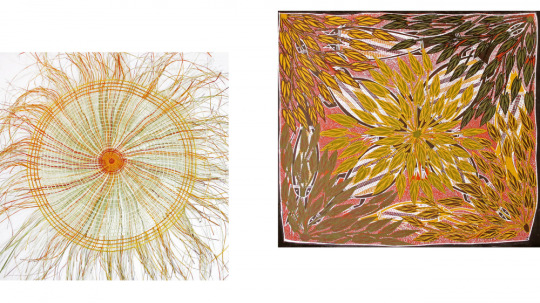
Left: Weaving by Evonne Munuyngu of Bula’bula Arts. Right: Banda (Long Neck) by Roy Burnyila of Bula’bula Arts
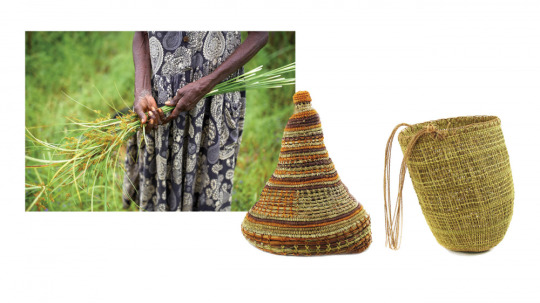
Left to right: Collecting for weaving, Weavings by Janice Djupuduwuy and Julie Djulibing Malibirr of Bula’bula Arts.
Bula’bula Arts
Based in the Yolgnu community of Ramingining in central Arnhem land, Bula’bula is an arts centre supporting 150 artists from the town and surrounding art stations. The centre’s online store sells bark and canvas paintings depicting stories of Yolgnu culture in ochre, white clay and charcoal; as well as weavings and fibre art woven from locally harvested materials such as pandanus, sand palm and kurrajong bark stained with natural dyes made from fruits, roots and leaves.
Visit the Bula’Bula Arts online store here and follow them on Instagram here.

Artwork by Johnny Warrkatja Gapuwiyak Culture and Arts. Image – courtesy of Gapuwiyak Culture and Arts.
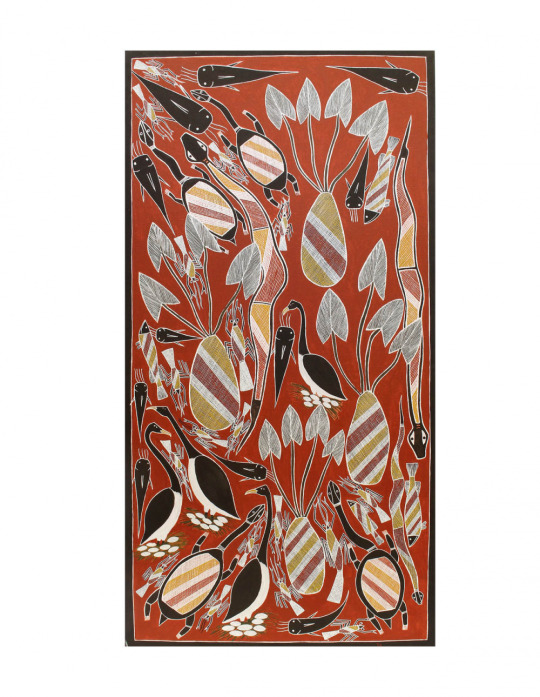
Artwork by Johnny Warrkatja of Gapuwiyak Culture and Arts. Image – courtesy of Gapuwiyak Culture and Arts.
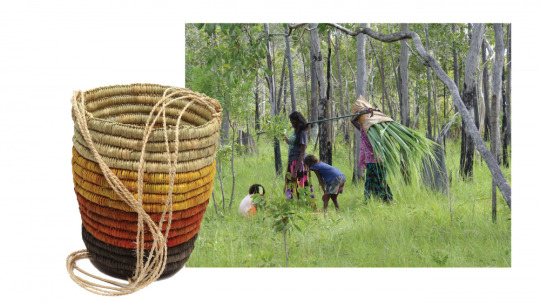
Gapuwiyak Culture And Arts
Gapuwiyak Culture and Arts is a remote Art Centre in east Arnhemland. There are eighteen clans in this region, each with their own interconnected clan estates, songs, patterns and designs.
The Art Centre is owned by Yolŋu members, have a Yolŋu Board, and employ a manager and arts workers, and supports over 100 artists from Gapuwiyak and surrounding homelands.
Artist Jason Marrkula is a Traditional Owner for the Gapuwiyak tribe and says ‘I like to share my culture with people through my art or by taking them to my land. I share my dreams, my stories with my mind and with my heart so people can learn about the land, the birds, the nature and our culture. This is really important for me.’
Visit the Gapuwiyak online store here and follow them on Instagram here.
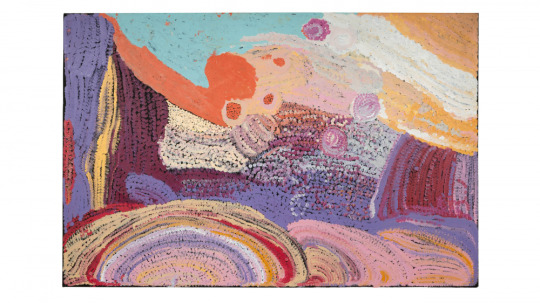
‘Untitled’ by Mulyatingki Marney and Nancy Nyanjilpayi of Spinifex Hill Artists.

‘Untitled’ by Nyangulya Katie Nalgood of Spinifex Hill Studio.
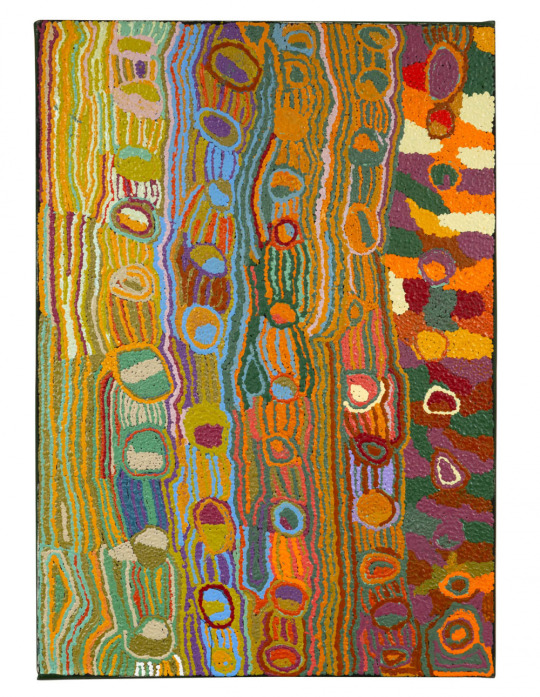
‘Wantili’ by Country Ngamaru Ngamaru Bidu of Spinifex Hill Studio.
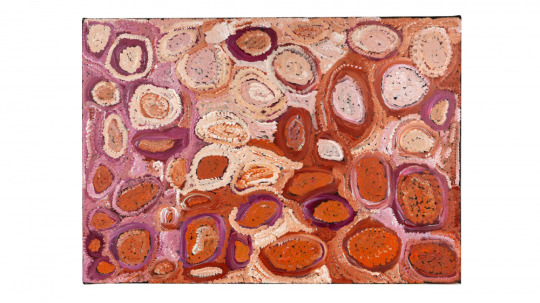
‘Jarntinti’ by Nyanglpayi Nancy Chapman of Spinifex Hill Studio.

Left: ‘Untitled’ by Doreen Chapman of Spinifex Hill Studio. Right: ‘Untitled’ by Selena Brown of Spinifex Hill Studio.
Spinifex Hill
Spinifex Hill Studio stands on Kariyarra Country in the Pilbara region of Western Australia. It is home to one of the youngest Aboriginal art collectives in the north-west of Australia, Spinifex Hill Artists.
Over 100 emerging, mid-career and established artists make regular use of the Studio facilities, with a primary focus on contemporary acrylic painting in bright, confident colours. These are artists from many different language groups, including Kariyarra, Banyjima, Mangala, Manyjiljarra, Martu, Noongar, Nyangumarta, Nyamal, Nyiyarparli, Walmajarri, Warnman, Yamatji, Yindjibarndi.
Spinifex Hill differs from others in this list in that it is managed by FORM, a Western Australian non-profit cultural organisation. The Studio, the Spinifex Hill Artists, and FORM’s Pilbara-programming is supported through a long-term partnership between FORM and BHP.
After 8 months in construction, Spinifex Hill has just celebrated the opening of a brand new, beautiful Project Space with a new group exhibition, Where We Go to Paint (you can view the catalogue here).
Spinifex Hill Artist Maggie Green (stay tuned for our TDF Collect exhibition with Maggie later this year!) says, ‘We do painting good here. Everyone coming here for painting.’
Visit the Spinifex Hill online store here and follow them on Instagram here.
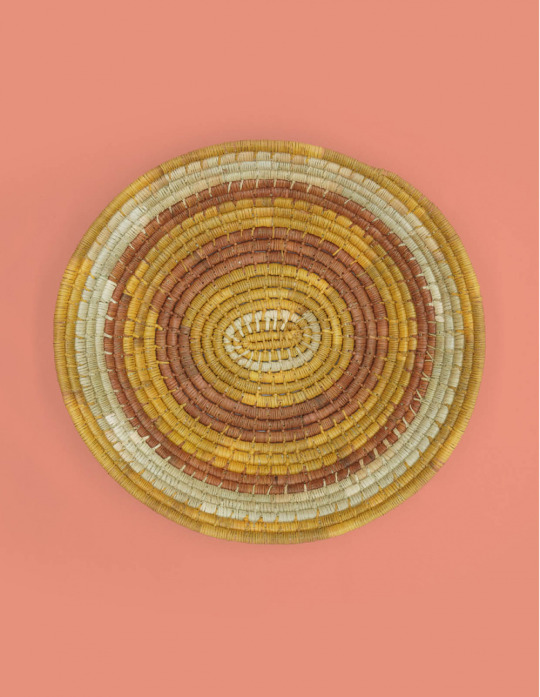
A woven piece by Numbulwar Numburindi artists. Photo – courtesy of Numbulwar Numburindi.

A woven piece by Numbulwar Numburindi artists. Photo – courtesy of Numbulwar Numburindi.
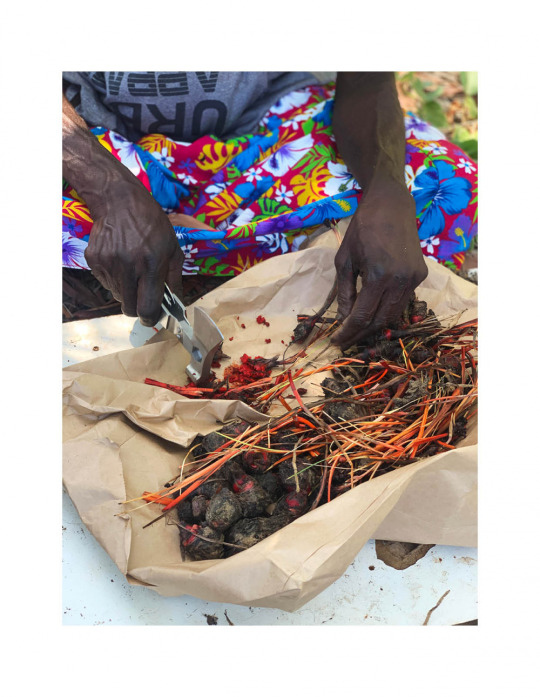
Photo – courtesy of Numbulwar Numburindi artists.
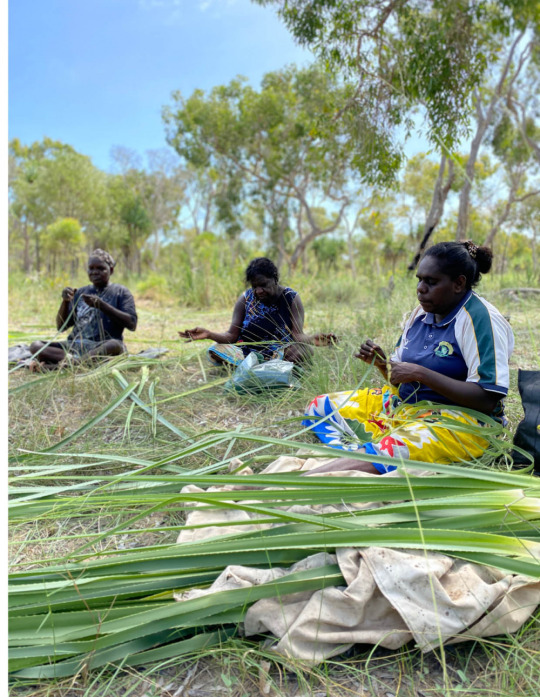
Ladies with pandanus. Photo – courtesy of Numbulwar Numburindi artists.

Woven pieces by Numbulwar Numburindi artists. Photo – courtesy of Numbulwar Numburindi.
Numbulwar Numburindi Arts
Numbulwar Numburindi Arts (NNA) was established in 2019, and is Numbulwar’s first art centre. It is Located on the Rose River on the western coast of the Gulf of Carpentaria (Northern Territory).
Here, artists combine naturally-dyed and locally-harvested pandanus with bright and bold ghost nets, abandoned fishing nets retrieved from Numbulwar’s shorelines. By harvesting ghost nets, the artists perform a modern act of caring for Country, and use the found materials to create intricate wulbung (baskets) and yir (dilly bags).
NNA IS 100% owned and and controlled by the Numburindi people, and employs Numburindi arts workers in the daily running of the Centre
Artist Lillian Joshua explains a little more of the collection of the nets used in NNA works: ‘My son is a sea ranger. He picks the ghost nets up and brings them to the old ladies to use with their weaving, saving marine life, as they are dangerous for animals like turtles and seals.’
Visit the Numbulwar Numburindi Arts online store here and follow them on Instagram here.
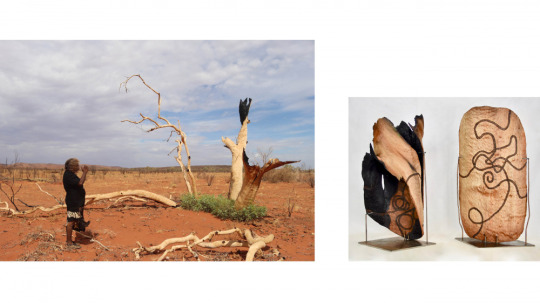
Left: Cynthia Burke on Country, Right: Artwork by Cynthia Burke of Maruku Arts.
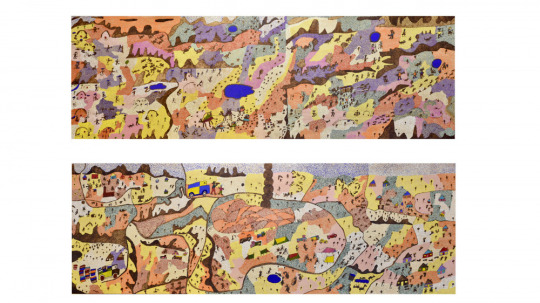
Artwork by Niningka Lewis of Maruku Arts.
Maruku Arts
For 35 years Maruku has operated as a not-for-profit art and craft corporation across 22 communities in the NPY Lands, serving more than 500 artists. They are 100% owned by Anangu (Aboriginal people of the Pitjantjatjara, Yankunytjatjara and Ngaanyatjara language groups). Maruku Arts is the only organisation concentrating on punu (wood carving) in the Central and Western Desert area.
Maruku, literally means “belonging to black”, today is one of the largest and most successful indigenous owned and operated organisations.
Located at the Mutitjulu Community within the Uluru – Kata Tjuta National Park, it services all the APY Lands communities, the Pitjantjara NT communities, and the Ngaanyatjara communities in Western Australia.
Maruku’s purpose is to keep culture strong and alive for future generations and to make culture accessible in an authentic and enduring way.
Currently, Maruku comprises of a warehouse based in Mutitjulu community and a retail gallery at Uluru-Kata Tjuta National Park Cultural Centre. Additional to the retail arm, Maruku offers tours, workshops, demonstrations, traditional ceremonies and exhibitions.
Visit the Maruku online store here and follow them on Instagram here.
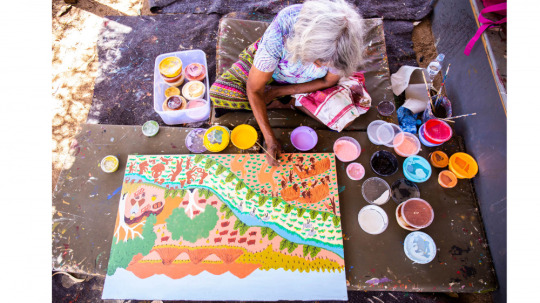
Nora Abbott in the studio. Photo – courtesy of Tangentyere Artists.

‘Tempe Down, That Country and the Animal that Belong’ by Marjorie ‘Nunga’ Williams, 2020. Image – courtesy of the artist and Tangentyere Artists.

‘When I was Young One’ by Grace Robinya, 2021. Image – courtesy of the artist and Tangentyere Artists.
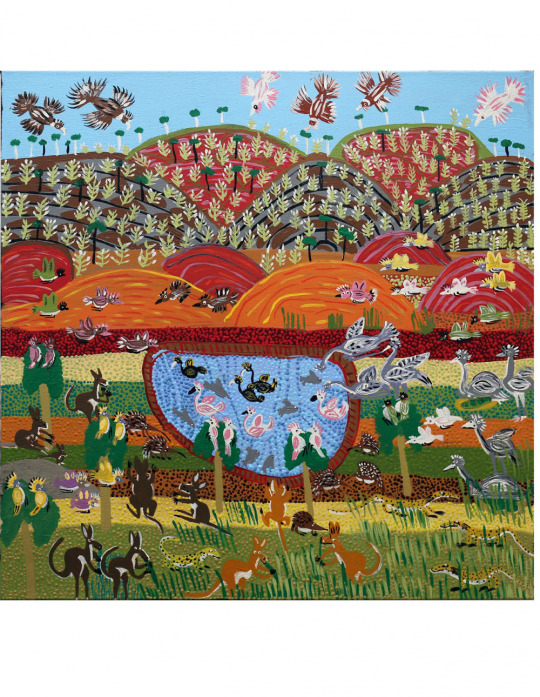
‘Waterhole inside Palm Valley’ by Joanne Napangardi Wheeler, 2021. Image – courtesy of the artist and Tangentyere Artists

‘Big Puta Puta After Rain’ by Nora Abbott, 2021. Image – courtesy of the artist and Tangentyere Artists
Tangentyere Art Centre
Established in 2005, Tangentyere Artists is an Aboriginal owned and run not-for-profit Art Centre in Mparntwe (Alice Springs). Tangentyere is an Arrernte word that means coming together, working together – which is exactly what they do.
Town Camp Artists communicate stories about their families, identity and lives in their artworks, and their practice aims to highlight the everyday experience of Aboriginal people in Central Australia. They are a hub for art activities across the 18 Town Camps of Mparntwe (Alice Springs), supporting emerging and established Town Camp artists through their studio, outreach program, gallery and online store
Artist April Spencer Napaltjarri says, ‘I love painting, telling stories with friends and family. I love coming here to Tangentyere Art Centre for a day of this, tea, people, canvas. Lots of people say hello! Hello! Happy people!’
Visit the Tangentyere Artists online store here and follow them on Instagram here.

Left to right: Tjulpus (birds) by Rochelle Ferguson, Tjilkamarta (echidna) by Lisa Armstrong, Papa (dog) by Katrina Tjitayi of Tjanpi Desert Weavers.

Left: Cynthia Burke from Warakurna (WA), 2019. Image by Jade Brockley Courtesy of Tjanpi Desert Weavers. Right: Umutja Toyota Come on Toyota! by Nellie Patterson of Tjanpi Desert Weavers.
Tjanpi Desert Weavers
Tjanpi Desert Weavers (Tjanpi meaning ‘wild grass’) is an award-winning, Indigenous governed and directed social enterprise of the Ngaanyatjarra, Pitjantjatjara and Yankunytjatjara Women’s Council (NPYWC). They empower over 400 Anangu minyma (Aboriginal women) to earn an income and remain in their communities on Country.
Building upon a long history of using natural fibres to make objects for ceremonial and daily use, Tjanpi artists create vibrant sculptures and baskets using native grasses, wool and raffia. In 2020, Tjanpi senior artist Tjunkaya Tapaya OAM won the Handcrafted Category of the TDF Design Awards!
Fibre artist Nyurpaya Kaika-Burton says, ‘Nowadays there are many different ways in which we transmit those ancient stories because we really hold these stories strong… this sculptural way is a whole new other way… we go out into the country to the actual place where these stories take place, where these dreaming tracks move through the country. We go there and we find materials. These sculptural pieces here are filled up with the story from the land.’
Visit the Tjanpi online store here and follow them on Instagram here.
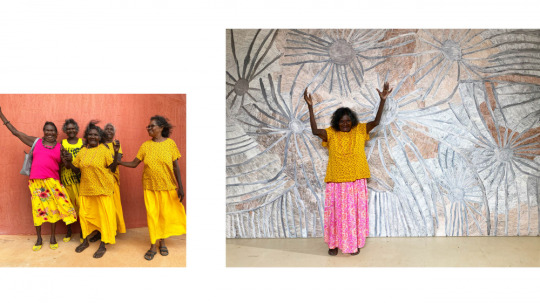
Left: Nyapanyapa Yunupingu with her family. Right: Artist Nyapanyapa Yunupingu celebrates finishing her huge work Djulpan-Seven Sisters. Photo – courtesy of Buku-Larrŋgay Mulka Centre.
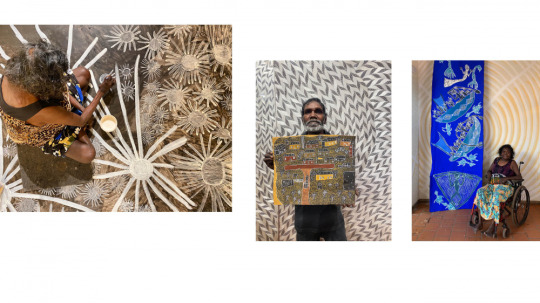
From left to right: Nyapanyapa Yunupingu working on a piece. Wanapa Munuŋgurr with his bark painting depicting his homeland community Wandawuy. Dhambit Munuŋgurr with part of her installation for the NGV Trienniel,
Buku-Larrnggay Mulka
Buku-Larrŋgay Mulka Centre is the Indigenous community controlled art centre of Northeast Arnhem Land. It is located in Yirrkala, a small Aboriginal community on the northeastern tip of the Top End of the Northern Territory, approximately 700km east of Darwin. The art centre has around 20 staff who are primarily Yolŋu, servicing Yirrkala and the approximately twenty-five homeland centres in a 200km radius.
The origins of the Buku-Larrŋgay Mulka Centre can be traced back to the 1960s with renowned artist Narritjin Maymuru, who is counted among the art centre’s main inspirations and founders. Buku-Larrŋgay Mulka Centre consists of two divisions; the Yirrkala Art Centre which represents Yolŋu artists exhibiting and selling contemporary art, and The Mulka Project which acts as a digital production studio and archiving centre incorporating the museum.
Buku-Larrŋgay means, ‘the feeling on your face as it is struck by the first rays of the sun’, and Mulka means, ‘a sacred but public ceremony.’
Visit the Buku-Larrnggay Mulka Centre online store here and follow them on Instagram here.
1 note
·
View note
Photo

“Luther wrote about living through the plague in a pamphlet titled Whether One May Flee from a Deadly Plague. Oxford University professor Lyndal Roper writes that while many fled Wittenberg in 1527 when the plague struck, Luther stayed out of a sense of duty to help nurse and care for the dying. This is what he thought all leaders should do. His staying was not the decision of a martyr, nor was it born of a naïve idea that God would necessarily save or protect him. Luther, writes Roper, “advocates social distancing”, the use of hospitals, and necessary precautions according to the science of his time. While he believed that God was ultimately in control, he also affirmed human responsibility. Luther harshly condemned those who went about knowing they were sick and spreading the disease.” (at SYDNEY EASTERN SUBURBS VIEW) https://www.instagram.com/p/CF25UlUFYZY/?igshid=9vkv2ta6dhl
0 notes
Text
Zurich Press Release - https://paulwesleychronicles.com/zurich-press-release/ #PaulWesley
New Post has been published on https://paulwesleychronicles.com/zurich-press-release/
Zurich Press Release

Paul Wesley of The CW’s “Vampire Diaries” & Austin Smith of Broadway’s Hamilton and An Octoroon Join the World Premiere of Colt Coeur’s
ZÜRICH By Amelia Roper
Directed by Adrienne Campbell-Holt Recipient of the 2018 Lortel Visionary Director Award Presented as part of New York Theatre Workshop’s
Inaugural NEXT DOOR Series April 14-May 5, 2018 Opening Night set for Tuesday, April 17 th The Fourth Street Theater 79 East 4 th Street New York, New York 10003
Colt Coeur is thrilled to announce that Zürich, a new play by Amelia Roper and directed by Adrienne Campbell-Holt (The Women’s Project’s What We’re Up Against, Colt Coeur’s Dry Land), will make its world premiere as part of the company’s 2017-2018 season. Presented as part of New York Theatre Workshop’s inaugural NEXT DOOR series, Zürich will begin performances on Saturday, April 14, 2018 at The Fourth Street Theatre (located at 79 East 4 th Street, between Cooper Square and 2 nd Avenue), with a final performance set for May 5, 2018. Opening night has been set for Tuesday, April 17, 2018.
Zürich is a series of two-handers, as hotel guests enjoy the last moments of their private, awkward, funny and not-so- funny lives. Grappling with nationalism, tourism, social responsibility, isolation, class and gender expectations, the play asks — in a time of global crisis, what does neutrality mean for a country full of banks? For any of us?
Zürich will star an ensemble cast that includes Samantha Blair Cutler (Dear Evan Hansen), Sami Molly Bray, Juliana Canfield, Gregory Diaz IV, Renata Friedman, Carolyn Holding, Lynne Lipton (Colt Coeur’s How to Live on Earth), Austin Smith (Hamilton on Broadway, An Octoroon at Soho Rep), Matthew Stadelmann (Colt Coeur’s Dry Land), and Paul Wesley (“Vampire Diaries,” Cal in Camo (Colt Coeur/Rattlestick)).
Zürich will feature scenic design by John McDermott, costume design by Tilly Grimes, lighting design by Grant Yeager, sound design by Brendan Aanes, properties by Samantha Shofner, and production management & technical direction by Daniel Prosky. The production will be produced by Colt Coeur, with Jessica Rieken serving as Line-Producer and Shannon Buhler serving as Associate Producer. In addition, Abbie Betts will serve as Production Stage Manager with Katie Cecil Cairns as Assistant Stage Manager.
Tickets for Zürich, starting at just $20, are available for purchase online at https://www.nytw.org/show/zurich/tickets/?spektrix_bounce=true For more information about Colt Coeur and Zürich, please visit www.coltcoeur.org
ABOUT COLT COEUR & ZÜRICH
Colt Coeur, an artists’ ensemble, collaboratively creates theater from the ground up. Founded in 2010, Colt Coeur has created and produced eight world-premieres: Seven Minutes in Heaven, together as a company with TONY-winning playwright Steven Levenson; Fish Eye, with playwright Lucas Kavner; Recall, by Eliza Clark; Everything is Ours, by Nikole Beckwith, and Dry Land, by Ruby Rae Spiegel, How to Live on Earth, by MJ Kaufman, aCal in Camo, by William Francis Hoffman (co-production with Rattlestick Playwrights Theater), and Empathitrax (by Ana Nogueira). All eight of Colt Coeur’s productions have been New York Times and/or Time Out New York critic’s picks and played to sold-out houses.
The performance schedule for Zürich is Thursdays through Mondays at 7:30pm beginning on Saturday, April 14th. There will be a special performance Tuesday, May 1 st at 7:30pm. Zürich will run through Saturday, May 5 th , with a closing night benefit performance and after-party for Colt Coeur.
Zürich was commissioned and developed by Colt Coeur, in partnership with the Virginia B. Toulmin Foundation.
Zürich is made possible by the New York State Council on the Arts with the support of Governor Andrew M. Cuomo and the New York State Legislature. This program is supported, in part, by public funds from the new york city department of cultural affairs in partnership with the city council.
ABOUT NEXT DOOR AT NEW YORK THEATRE WORKSHOP
Next Door at NYTW provides a home for companies and artists who are producing their own work. Meeting the artists where they are in their process, this initiative provides each project with subsidized resources and space for development and performance in the newly renovated Fourth Street Theatre. As part of an ongoing effort to expand support for artists at every stage of their careers, this series will serve nearly 100 additional artists in the first year alone.
ABOUT THE ARTISTS
AMELIA ROPER (Playwright) is an award winning Australian-American writer and activist, currently writing for the Oregon Shakespeare Festival, Marin Theatre Company, The Rose and adapting Two Serious Ladies by Jane Bowles for Yale Repertory Theatre. Her plays have been seen in Moscow, London, Sydney, Melbourne, the Humana Festival of New American Plays at ATL, Taffety Punk in DC, Square Product in Boulder, Prelude Festival NYC and Crowded Fire in SF. Showcase and developments include the Old Vic in London, Soho Rep Writer / Director Lab, Black Swan Lab at OSF, Berkeley Rep’s Ground Floor, Kennedy Center in DC, Playwrights Realm in NYC, New Group NYC, The MacDowell Colony, Black Swan at OSF and Boston Court in LA. Published plays include Big Sky Town, Camberwell House and She Rode Horses Like The Stock Exchange with an introduction by Sarah Ruhl. New plays include Lottie in the Late Afternoon, Everything Is Nice, Aliya In Americaland and A Duck On A Bike. She works on the Netflix / Jenji Kohan show “GLOW”, develops TV and features in LA and Australia, works for Gloria Steinem, and is one of the original Hollywood women involved in the Time’sUp movement. Amelia has an MFA in playwriting from the Yale School of Drama.
ADRIENNE CAMPBELL-HOLT (Director) is the Founding Artistic Director of Colt Coeur, a Brooklyn-based theatre company and the recipient of the 2018 Lucille Lortel Visionary Director Award. Upcoming: Downstairs by Theresa Rebeck at Primary Stages. Recent: Afterwords, a new musical by Zoe Sarnak and Emily Kaczmarek (Village Theater, Seattle), What We’re Up Against (WP Theater), world premiere of Empathitrax by Ana Nogueira (Colt Coeur @ HERE, 2016), world premiere of Cal in Camo by William Francis Hoffman (co-pro Rattlestick & Colt Coeur), Dear Elizabeth by Sarah Ruhl (Dorset Theater Festival). Other world premieres: Theresa Rebeck’s The Nest (Denver Theatre Company), One Child Born (Oberon at American Repertory Theater), How to Live on Earth by MJ Kaufman (Colt Coeur), Chiara Atik’s 52 nd to Bowery (EST Marathon), Dry Land by Ruby Rae Spiegel (Colt Coeur), Greg Moss’ REUNION (South Coast Rep), Everything is Ours by Nikole Beckwith (Colt Coeur), Recall by Eliza Clark (Colt Coeur), Fish Eye (Colt Coeur), Seven Minutes in Heaven by Steven Levenson (Colt Coeur). Adrienne is a Time Warner/Women’s Project Lab 2014-2016 Fellow. She has developed work with La Jolla Playhouse, Roundabout Theater Company, Playwrights Horizons, Clubbed Thumb, New Georges, Playwrights’ Center and EST. She is also the director of #makeitfair and the Associate Director on the Broadway production of Dear Evan Hansen. BA Barnard College, Columbia University.
#Adrienne Campbell-Holt#Amelia Roper#Colt Coeur#March 28 2018#Paul Wesley#Press Release#The Fourth Street Theater#Zurich
1 note
·
View note

